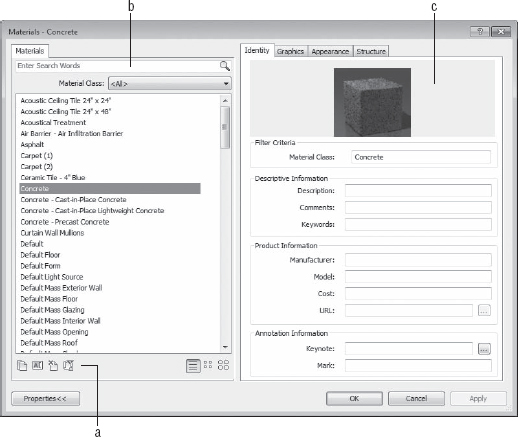Customizing Project Settings for Graphic Quality
One of the most common complaints from teams implementing Revit on their first projects is poor graphic quality of printed documents. When you first install the software, only some default settings are defined to approximate a standard graphic appearance of architectural drawings. For example, walls cut in sections are thicker than those shown in projected views and callout boundaries are dashed; however, all annotation categories are set to a line weight of 1. Fortunately, you can easily overcome these problems with some basic configuration.
Object Styles
![]() The primary means of controlling graphic consistency throughout a project is through object styles. To access these settings, switch to the Manage tab and choose Object Styles from the Settings panel. As shown in Figure 4.2, the dialog box is divided into four tabs: Model Objects, Annotation Objects, Analytical Model Objects, and Imported Objects. Settings for line weight, line color, line pattern, and material are established for each category.
The primary means of controlling graphic consistency throughout a project is through object styles. To access these settings, switch to the Manage tab and choose Object Styles from the Settings panel. As shown in Figure 4.2, the dialog box is divided into four tabs: Model Objects, Annotation Objects, Analytical Model Objects, and Imported Objects. Settings for line weight, line color, line pattern, and material are established for each category.
Model Objects The Category column on the Model Objects tab lists all available categories and subcategories of model elements. It is important to note that the subcategories for model and annotation objects are created in families, which are loaded into the project or template. This will be discussed in greater detail in Chapter 15, “Family Editor.”
The next two columns, under Line Weight, define the line weight used when the elements are displayed in projection or cut modes. In some categories, the Cut setting is unavailable; these element categories will never be cut in plan or section views, regardless of the location of the view's cut plane. For other categories that enable Cut display, element geometry in the Family Editor can be set to follow that rule or not, as shown in Figure 4.3.
FIGURE 4.2 The Object Styles dialog box gives you graphic control of all Revit categories and their subcategories.

FIGURE 4.3 Customizing the cut display of geometry in a family

Line Color and Line Pattern allow you to customize the display properties of each category and subcategory, but remember that printing a Revit view is WYSIWYG (what you see is what you get)—colors will print as colors unless you override them to print as grayscale or black in the Print Setup dialog box. The last column, Material, allows you to define a default material to be associated with the category or subcategory in case family components in that category don't have materials explicitly defined. If a family has materials set to By Category, it references the material set in Object Styles.
Annotation Objects The Annotation Objects tab is similar to the Model Objects tab except there are no material definitions. There is also only one column for line weight (Projection) because lines do not have three-dimensional properties like model objects and cannot be “cut.”
Analytical Model Objects This tab is new to Revit 2012 and allows you to color the various physical conditions in the building that correspond to the building's structural components.

Imported Objects You can control the graphic appearance of layers (DWG) and levels (DGN) within linked or imported CAD files throughout the project on the Imported Objects tab of the Object Styles dialog box; however, we will cover this in greater detail in Chapter 8, “Interoperability: Working Multiplatform.”
ASSIGNING LINE WEIGHT 1
You may want to avoid assigning line weight 1 to objects, because this is the weight used by most fill patterns. Reserving its use will help object profiles stand out compared to their patterns.
Line Settings
You can use lines in a variety of ways in Revit. Some lines relate to obvious tools such as detail lines and model lines, whereas you can place others with filled regions and by using the Linework tool. Lines also relate to the graphic representation of model and annotation elements, as previously discussed. Achieving the desired graphic quality requires a review of Revit's line weights, patterns, and styles.
SETTING LINE WEIGHTS
To open Revit's line weight settings, click the Manage tab and choose the Additional Settings flyout from the Settings panel. Click the Lineweights button ![]() on this menu. The dialog box shown in Figure 4.4 manages the printed line weights relative to a numbered assignment from 1 to 16. For model objects, heavier line weights vary between view scales. If you require more granular control between scales, click the Add button to insert another scale value column and edit the line weights as required.
on this menu. The dialog box shown in Figure 4.4 manages the printed line weights relative to a numbered assignment from 1 to 16. For model objects, heavier line weights vary between view scales. If you require more granular control between scales, click the Add button to insert another scale value column and edit the line weights as required.
FIGURE 4.4 Model line weights vary depending on the view scale.
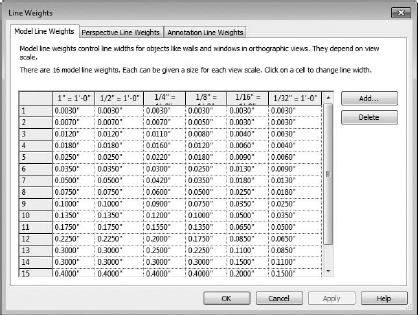
We recommend that you first customize the graphic appearance of model and annotation elements with object styles before trying to manipulate any of the information in this dialog box. You should only attempt to refine the line weight settings with a rigorous investigation of printed views in multiple scales, as changes in one area can have an impact on several others.
SETTING LINE PATTERNS
Repetitive series of line segments, spaces, and points comprise line patterns in Revit. To edit or create line patterns, switch to the Manage tab and choose Additional Settings ![]() Line Patterns
Line Patterns ![]() . The Line Patterns dialog box, shown in Figure 4.5, displays a list of existing line patterns in the project.
. The Line Patterns dialog box, shown in Figure 4.5, displays a list of existing line patterns in the project.
FIGURE 4.5 This dialog box displays all line patterns in the project.
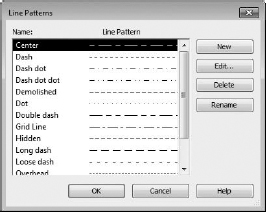
To edit an existing pattern, click the Edit button, or click New to create your own. You create patterns by specifying dash and space lengths, which will form a repeating sequence, as shown in Figure 4.6. For dots, a length value isn't required.
FIGURE 4.6 Line patterns consist of dashes, spaces, and dots.

USE CAUTION WHEN DELETING LINE PATTERNS
Before deleting a line pattern, you must verify that it hasn't been used anywhere in your project. You can do so only by manually checking Object Styles, Line Styles, and Visibility/Graphic Overrides. If you fail to do so, all line styles using the deleted pattern will be assigned as Solid.
Frequently, a line pattern is required to include a symbol or text for elements such as fence lines, piping, or underground utilities. In AutoCAD, shape definitions could be used within linetype definitions to achieve the desired results. In Revit, these special lines can be created as line-based detail components. A sample of this type of custom line can be found by downloading the file c04-Lines.rvt from this book's companion web page at www.sybex.com/go/masteringrevit2012.
CREATING A NEW LINE PATTERN
Follow these steps to create a new simple line pattern:
- Switch to the Manage tab and choose Additional Settings
 Line Patterns.
Line Patterns. - In the Line Pattern dialog box, click New.
- Give the new line pattern a name.
- Define the sequence, as shown here:

- Confirm by clicking OK.
The resulting line pattern looks like this:
SETTING LINE STYLES
Now that we have discussed the basic components of lines—color, weight, and pattern—the three are combined to create line styles for use in detail lines, model lines, filled regions, and masking regions. They are also available when the Linework tool is used to override a part of a model element. You will find the button that opens the Line Styles dialog box (shown in Figure 4.7) on the Manage tab under Additional Settings ![]() .
.
FIGURE 4.7 Line styles consist of weight, color, and pattern.
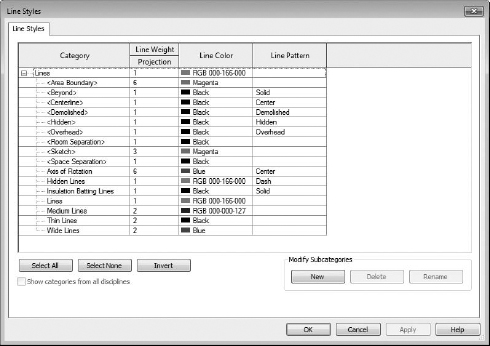
In the Line Styles dialog box, notice that some of the style names are bracketed—for example, <Hidden>. These are internal, “system” types of lines that cannot be renamed or deleted; however, their weight, color, and pattern can be modified.
USE CAUTION WHEN DELETING LINE STYLES
If you delete a line style used in a project, any elements utilizing the deleted style will be unable to reference that style anymore. The lines assigned to the deleted style will be reassigned to a common style such as Thin Lines—possibly producing undesirable results.
Establishing the best styles for your templates will be completely up to you, but we will offer some proven examples for inspiration. First, realize that Revit already uses common line styles such as Thin Lines, Medium Lines, and Wide Lines. If you are creating a complete array of customized line styles for your colleagues to use, rename the common styles to fit into your standard.
One common approach is to create line styles organized by their weight number along with any variable to its appearance, such as (3) Gray Dashed. Note that the parentheses (or the use of any special characters at the beginning of the line's name) keep your custom line styles sorted to the top of the list in the Line Styles dialog box as well as in the Type Selector when you're using a line-based tool. This approach has proven to be effective and efficient when creating details in drafting views or generating fill or masking regions.
Another approach reserves certain line styles for special circumstances where lines represent aspects of a building in a plan, elevation, or section and must be assigned to a specific layer when views are exported in CAD format. For example, the crossing lines typically used to indicate an area in plan that is “Open to Below” may need to be assigned to the CAD layer “A-FLOR-BELW.” This is difficult if you used a line style based solely on weight and pattern such as (2) Dashed. You cannot separately assign that line style to “A-FLOR-BELW” for the floor plan export and “A-DETL-THIN” for all other exports. Here are some examples of line styles you could create:
- Open to Below
- ADA Circles
- Curbs
- Fire Rating
In summary, take care to understand the different settings when you are beginning to customize graphic settings for lines in the Revit template. To change the displayed weight of an element in a project, changes should not be made in Line Weights but rather through the Object Styles dialog box. For example, if you want to increase the cut line weight of a wall already set to (5), do not increase the value of (5) in the Line Weights dialog box. You would change this value by selecting (6) or (7) as the cut weight of a wall in the Object Styles dialog box.
Materials
![]() Defining materials in your project template is another important task that can help maintain graphic consistency in many other areas of Revit. Materials drive the graphic representation of elements—not just in a rendered view—but in hidden line views, 2D or 3D. They are also responsible for cleanups because materials can merge with one another when elements of the same material are joined. A material can define how an element is annotated within the model and how an element's surface looks in shaded views, when cut in plan or section, and when seen in 3D views. In Figure 4.8, the surface patterns are all derived from the material used in the element.
Defining materials in your project template is another important task that can help maintain graphic consistency in many other areas of Revit. Materials drive the graphic representation of elements—not just in a rendered view—but in hidden line views, 2D or 3D. They are also responsible for cleanups because materials can merge with one another when elements of the same material are joined. A material can define how an element is annotated within the model and how an element's surface looks in shaded views, when cut in plan or section, and when seen in 3D views. In Figure 4.8, the surface patterns are all derived from the material used in the element.
FIGURE 4.8 Materials define the surface and cut patterns, color, and render material of the elements.

![]() To access the Materials Editor (Figure 4.9), switch to the Manage tab and choose Materials on the Settings panel. At the lower left of the dialog box (a) are icons for basic editing commands—duplicate, rename, and delete. At the upper left (b) is a search bar for quickly locating specific materials in the project and all material properties are found at the right side (c) of the dialog box.
To access the Materials Editor (Figure 4.9), switch to the Manage tab and choose Materials on the Settings panel. At the lower left of the dialog box (a) are icons for basic editing commands—duplicate, rename, and delete. At the upper left (b) is a search bar for quickly locating specific materials in the project and all material properties are found at the right side (c) of the dialog box.
FIGURE 4.9 Manage material properties using the Materials Editor.
MATERIAL PROPERTIES
The material properties are divided into four tabs: Identity, Graphics, Appearance, and Structure.
Identity Defines schedule values and keynotes for materials. Specifying correct identity data for your standard or typical materials will increase efficiency when you're using annotation such as material tags as well as facilitate quality management by aligning model data such as manufacturer, model, and mark with your project specifications. In Figure 4.10, some sample identity data has been entered. Notice how the Material Class field can be customized to group project materials. Keywords can be entered for use with the Search bar and cost data has been entered for use in a Material Takeoff schedule. The use of material identity data in project annotation and detailing is discussed in greater detail in Chapter 19, “Annotating Your Design.”
Graphics Defines shading color, surface patterns, and cut patterns:
FIGURE 4.10 Use identity data to classify, find, tag, and schedule materials.

Appearance Defines rendering attributes. Click the Render Appearance tab to view render properties. These properties will only become visible when you render a view and will not affect construction documentation graphics.

Structure Defines structural properties of a material for analysis.

MATERIAL STRATEGIES
It may seem impossible to imagine all the materials you'll need in a project, making building a template seem daunting. Think of the basic materials you're likely to use—wood, brick, concrete, glass, and so on—and build from those. Remember, a template is just a starting point, and you can always expand it. If you end up making a lot of nice materials over the course of a project, use the Transfer Project Standards function to move materials back into your templates.
When you start to organize materials in Revit by name, there are many prevailing theories too numerous to list here, but here are a few suggestions:
By Type Each material is prefixed with a descriptor such as Metal, Paint, Carpet, Wood, and so on.
By Use Each material is prefixed with a description of its application such as Cladding, Interior, Exterior, Site, and so on.
Alphabetical Materials have no prefixes.
By CSI Division Each material is prefixed with a MasterFormat numerical descriptor corresponding to its specification section.
By Mark Each material is prefixed with the designation of its Mark annotation parameter (for example, WD01-Wood-Cherry).
CREATING A SIMPLE EXTERIOR GLAZING MATERIAL
In the early phases of design, you may want to keep the level of detail to a minimum. In fact, guidelines for modeling levels of development may be established as part of a BIM execution plan (see AIA E202 BIM Protocol Exhibit at www.aiacontractdocuments.org/bim or the model progression specification at www.ipd-ca.net). To simplify the creation of exterior enclosures such as a curtain wall, try creating a glass material with a surface pattern approximating the layout dimensions of a curtain wall system (such as 5″ × 12″). Then create a generic wall type using this material, and you will have a much lighter wall type to explore design options with great ease.
Fill Patterns
Materials are often represented with simple hatch patterns. For any material used in Revit, you can define a surface pattern and a cut pattern. For simple parallel hatches and crosshatches, you can use the patterns already supplied in Revit or you can make your own patterns.
For more complex patterns, you need to import an external pattern file (with the file extension .pat). Such pattern definitions can be imported from pattern files used by AutoCAD—a process we explain later in this chapter. To create, modify, or view an available fill pattern, switch to the Manage tab and choose Additional Settings ![]() Fill Patterns (see Figure 4.11). On the left side of the Fill Patterns dialog box, you can view the names and small graphic previews of the patterns. Below those are the Pattern Type options, where you choose what type of patterns to create and specify what type of pattern you wish to edit (Drafting or Model).
Fill Patterns (see Figure 4.11). On the left side of the Fill Patterns dialog box, you can view the names and small graphic previews of the patterns. Below those are the Pattern Type options, where you choose what type of patterns to create and specify what type of pattern you wish to edit (Drafting or Model).
FIGURE 4.11 Fill patterns are defined separately for drafting and model representations.
Model patterns are used to convey real-world dimensional patterns to represent a material, whereas drafting patterns are intended for symbolic representations. For example, a model pattern is used to show a brick pattern in 3D and elevation views, whereas a brick drafting pattern is used to represent the material in plan and section. Figure 4.12 shows how concrete masonry units (CMUs) are represented with a running bond pattern (model) as well as a crosshatch (drafting).
FIGURE 4.12 The CMU wall has both a drafting pattern (cut) and a model pattern (surface) defined.
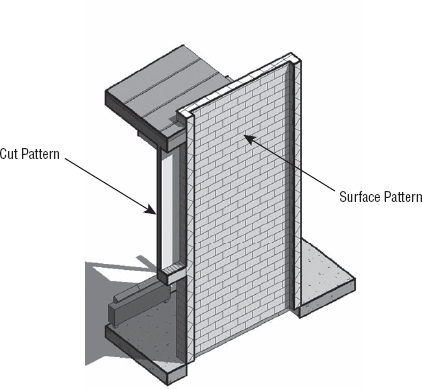
Model and drafting patterns have specific behaviors. In this example, you have a CMU wall with blocks that measure 16″ × 8″ [400 mm × 200 mm], regardless of the view scale. With a drafting pattern, the opposite is true: The pattern adjusts with the view scale, so the pattern looks identical in all scales.
CREATING A NEW DRAFTING PATTERN
To create a new pattern, first choose either Model or Drafting, and then click the New button. A generic pattern appears in the New Pattern dialog box. You can then design your pattern and assign behaviors.
The option Orientation In Host Layers is particularly useful when you're making drafting patterns. This option allows you to specify how a pattern orients itself relative to host elements such as walls, floors, roofs, and ceilings when they're represented as cut. Note that the option isn't available for model pattern types. As shown in Figure 4.13, the orientation options are Orient To View, Keep Readable, and Align With Element.
FIGURE 4.13 From left to right: Orient To View, Keep Readable, and Align With Element
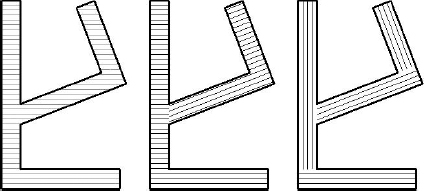
Orient To View When this orientation is applied, the patterns used in the project all have the same orientation and the same origin. They're always perfectly aligned with the origin of the view.
Keep Readable This orientation will maintain alignment with the view (i.e., horizontal lines will remain horizontal), but will be adjusted relative to angled host elements.
Align With Element This orientation ensures that the pattern orientation depends on the orientation of the host element. Patterns essentially run parallel with the element.
You can choose to make either simple or custom patterns with this dialog box, using the radio button options. Figure 4.14 illustrates some examples of each option:
FIGURE 4.14 From left to right: simple fill pattern, simple fill pattern with the crosshatch option selected, and a custom fill pattern

Simple These patterns are generated with parallel or crosshatch lines that can have different angles and spacing. With both the crosshatch and parallel options, you can specify only one angle for the entire pattern. Using crosshatch, you can set two spacing values.
Custom To create a more complex custom pattern, you have to import a pattern (PAT) file from an external source. This is often necessary because of Revit's current limitation in creating natively complex patterns. Your office may have a set of established patterns they've been using for years, and the Custom option allows you to import and reuse them without having to make them again from scratch. Custom patterns let you import a PAT file from anywhere on your hard drive or on a network and use it as a base pattern for a new fill pattern in Revit. The next section shows best practices for importing a PAT file.
CREATING A CUSTOM COMPLEX PATTERN
Custom patterns require an external file that contains the definition of the pattern. The file extension of that pattern should be .pat, which is what you'll make in this section by editing an existing AutoCAD PAT file. An advantage of specifying patterns in the template file is that the PAT file won't need to be installed on each computer where Revit is installed; Revit stores each pattern internally in each template or project.
Before modifying PAT files, always make a copy of the original PAT file you intend to use as a base; you don't want to risk messing up other files that might already be using that original PAT file. PAT files can be edited with Notepad, but any text-editing application will also do. For this exercise, you'll choose the AutoCAD pattern called Grass, which you can find in acadiso.PAT (in metric units) or acad.pat (Imperial units) located on this book's web page.
IMPORTING A CUSTOM PATTERN
Follow these steps to make a custom fill pattern by importing an existing pattern definition:
- Using Notepad, open the file acadiso.PAT or acad.PAT.
- Highlight the lines that define the pattern, and select them:
45, 6.35, 0, 4.49013, 4.49013, 1.5875, −5.80526, 1.5875, −8.98026 *GRASS, turfed surface 90, 0, 0, 17.9605, 17.9605, 4.7625, −31.1585 45, 0, 0, 0, 25.4, 4.7625, −20.6375 135, 0, 0, 0, 25.4, 4.7625, −20.6375 *GRATE, grid 0, 0, 0, 0, 0.79375
- Choose Edit
 Copy.
Copy. - Open a new text file, and paste the selection. (You can also open the PAT file located in C:Program FilesAutodeskRevit Architecture 2012Data, in which all Revit patterns are already saved. In that case, you can paste the selected text in that file.)
- This is the important part: In the new text file where you pasted the selected text, add the two lines shown highlighted here:
;%UNITS=MM *GRASS, turfed surface ;%TYPE=DRAFTING 90, 0, 0, 17.9605, 17.9605, 4.7625, −31.1585 45, 0, 0, 0, 25.4, 4.7625, −20.6375 135, 0, 0, 0, 25.4, 4.7625, −20.6375
The first line that you write before the pattern text, ;%UNITS=MM, can appear only once in the text file. It defines the value for the units used in the pattern. In the example, the units are millimeters (MM); if you wanted to work in imperial units, it would be ;%UNITS=INCH. (If you use the option in step 4 to collect all patterns in the master PAT file, then this line already exists and you don't need to add it.)
The second statement, ;%TYPE=DRAFTING, helps define whether you're creating a drafting or model pattern. In this example, the pattern is the Drafting type.
- Save your text file with a .pat file extension.
- In Revit, on the Manage tab, choose Additional Settings
 Fill Patterns.
Fill Patterns. - In the Fill Patterns dialog box, verify that the Drafting option is selected, and click New.
- In the New Pattern dialog box, select the Custom option. The lower part of the dialog box offers new options.
- Click Import.
IMPORTING PAT FILES
It's important to know that when you import a new pattern, the type of pattern needs to be the same as the new type of pattern you're making. In other words, if you're making a new model pattern, you can't import a drafting pattern. If you try to do so, you'll see a warning message like the one shown here:

- Navigate to the place on your hard drive or network where you saved the PAT file, and click Open.
- In the list that appears to the right of this button, you can see the name of the pattern you created: GRASS, as shown in Figure 4.15. (If you have a PAT file with many patterns defined, you see all the other drafting patterns available in that list.) The name of the pattern automatically becomes the name of your fill pattern, but you can change that if you like.
FIGURE 4.15 The New Pattern dialog box displays the imported PAT file in the Custom group.
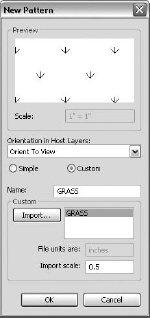
- If necessary, you can adjust the scales of the imported pattern. The Preview window displays the graphic of the pattern, always in 1:1 scale. This informs you if you need to scale the pattern up or down. You'll know that you need to scale the pattern if the preview appears as a solid black box—that means the pattern is too dense.
- If you're happy with the result, confirm by clicking OK.
Color Schemes
The use of color schemes in project documentation will be covered in greater detail in Chapter 20, “Presenting Your Design”; however, for now, just know that you can preconfigure them in project templates for a variety of scenarios. As an example, an architect may perform many projects for a single client who utilizes the same department names in all of their program design requirements. The architect would like to ensure that the colored plans in all projects for this client use the identical color scheme. In the following steps, you will create a new color fill legend with some predefined department values and associated colors to be saved in a custom project template.
 On the Home tab, go to the Room & Area panel and select the Legend tool.
On the Home tab, go to the Room & Area panel and select the Legend tool.- Place a legend in any available floor plan view, and you will see the Choose Space Type And Color Scheme dialog box, as shown in Figure 4.16. Set Space Types to Rooms and Color Scheme to Department. (These choices can be modified later.)
FIGURE 4.16 Select criteria for assigning a color scheme to a view.
 Select the color fill legend you placed in the previous step and find the Edit Scheme icon at the right end of the ribbon. The Edit Color Scheme dialog box will appear, as shown in Figure 4.17.
Select the color fill legend you placed in the previous step and find the Edit Scheme icon at the right end of the ribbon. The Edit Color Scheme dialog box will appear, as shown in Figure 4.17.
FIGURE 4.17 Edit color schemes to add predefined values, colors, and fill patterns.

- As shown in Figure 4.17, click the Add Value icon to populate the list of departments in the Scheme Definition area. Choose colors and fill patterns according to your graphic requirements.
- Click OK to close the dialog box.
- Open the floor plan, Level 1 and use the Wall tool to create some walls that are bound on all sides (so you can drop room elements into them). Now, from the Home tab, choose the Room button and add rooms to the plan. You won't want to let these remain in the template, but it will help to better visualize the color schemes if you can see them collocated.
- When rooms are placed, you can either type values for departments that match the predefined values in the color scheme or select the values in the element properties of the room, as shown in Figure 4.18.
FIGURE 4.18 Select from predefined values in the Properties dialog box of a room.
As shown in Figure 4.19, the department values utilized in every project started with your project template will have the same colors and fill patterns according to those specified in the original color scheme. You also have a predefined list of your client's department names.
FIGURE 4.19 Color-filled plans can utilize predefined values in templates.

You can download the sample file c04-AreaPlans.rvt from this book's web page.

